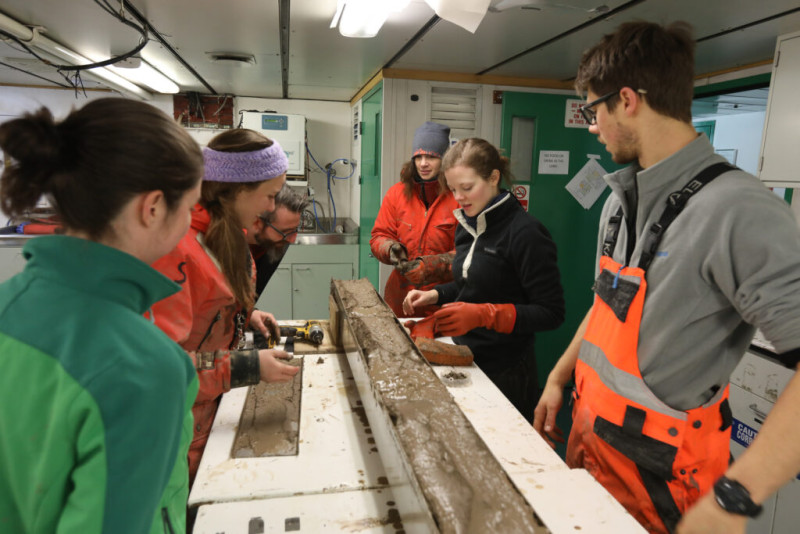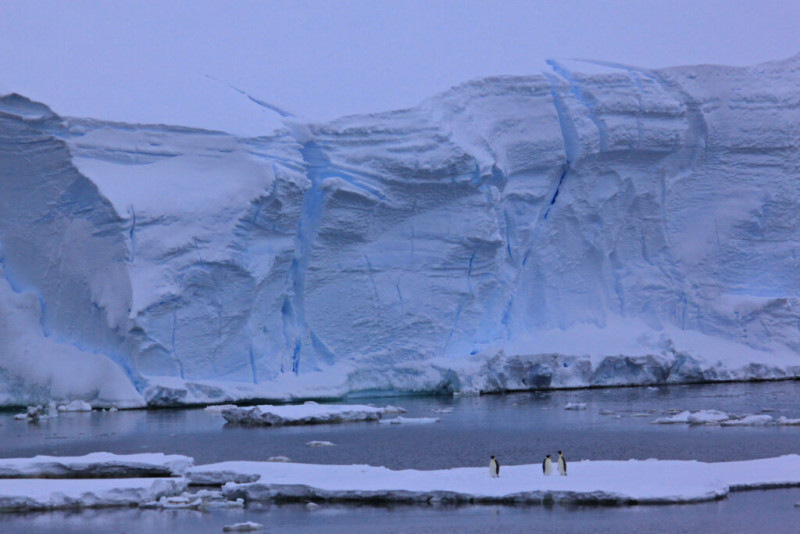New Research from Antarctica Affirms The Threat of the ‘Doomsday Glacier,’ But Funding to Keep Studying it Is Running Out
When he saw the 75-mile wide ice front of the remote Thwaites Glacier looming out of the Amundsen Sea for the first time in 2019, ice researcher James Kirkham felt a sense of foreboding.
“It was about four or 5 in the morning and just getting light, and then out of the gloom emerges this humongous wall of ice stretching for kilometers,” said Kirkham, who was on a research cruise aboard the United States Antarctic Program’s Nathaniel B. Palmer, collecting seafloor sediment samples from closer to the edge of the floating ice than ever before.
“It felt like this was the sort of thing that could cause the end of a lot of civilizations, a lot of cities, a lot of people’s lives,” he said. “It really brings home the scale of the problem of sea level rise. When you think about populations in New Orleans, in Bangladesh, and along coastlines all around the world, this is where the threat really lies.”
We’re hiring!
Please take a look at the new openings in our newsroom.
See jobsIt took a whole day of sailing just to monitor and map the front of the Thwaites Glacier’s floating shelf, he said, with ice cliffs in some places towering several hundred feet above the water, marking the abrupt edge of an ice expanse about the size of Nebraska and averaging between 2,500 and 4,000 feet thick. If all the ice melts, it would raise average global sea level about 2 feet.
The sediment samples Kirkham and other scientists collected four years ago provided the data for a study published Monday in the Proceedings of the National Academies of Sciences that affirms one of the most serious concerns about Antarctica—that an irreversible meltdown of some of the frozen continent’s ice masses has already started.

“You just can’t ignore what’s happening on this glacier,” said lead author Rachel Clark, a University of Houston ice researcher who also works with the International Thwaites Glacier Collaboration, a team that has been trying to figure out just how fast the vulnerable ice will melt. But, she said the new study is important because it shows that the melting is not just random or limited to one glacier.
“It is part of a larger context of a changing climate,” she said.
Not Just Thwaites
After analyzing the chemistry and other characteristics of seafloor sediment grains from various depths and different locations near the floating edge of the glacier, the team’s members were able to show that the glacier had been relatively stable for nearly 10,000 years, since the end of the last ice age, but that it started to retreat in the mid-1940s.
The scientists said they suspect that a prolonged El Niño warm phase in the Pacific Ocean from 1939 to 1942 jump started the retreat, and that subsequent warming kept the process going.
Shifts in regional winds and associated changes in ocean currents are pushing more relatively warm water toward Antarctica’s frozen fringe, melting the ice and loosening it from rocky seafloor anchor points that have held the floating part of the glacier in place for thousands of years. As the ice melts away from the pinning points, it can float to sea and disintegrate faster, allowing the glacier behind it to accelerate toward the ocean. In the last 30 years, the amount of ice flowing out to sea from the Thwaites and Pine Island glacial areas and their associated floating ice shelves has doubled.
Co-author Julia Wellner, a University of Houston associate professor of geology and U.S. lead investigator of the Thwaites Offshore Research project, or THOR, said it’s significant that the Thwaites Glacier, and the neighboring Pine Island Glacier, have kept retreating since the 1940s.
Because the two glaciers reacted in sync with each other, the findings also affirm the retreat was caused by external factors, rather than internal glacier dynamics, she said. “Once the system is kicked out of balance, the retreat is ongoing,” she added.
While the Thwaites Glacier has been identified as being among the most vulnerable to pinning point loss, a similar pattern of melting and retreat in many other Antarctic glaciers and ice shelves at least since the 1970s was documented in a separate study published Feb. 21 in Nature.
Using satellite images, the researchers found a “marked, widespread and accelerating unanchoring of ice shelves from pinning points,” including in parts of East Antarctica that were long assumed to be less vulnerable to melting.
“The loss of many of these pinning points is likely to be permanent,” the authors of the Nature paper wrote, noting that, over decades, the loss of the anchors holding the ice shelves in place could be the first step in loss of the huge sheets of ice they hold back.
Flying Blind?
There’s evidence that much of the ice in West Antarctica vanished during previous warm geological epochs, and knowing how fast it will melt and raise sea level in the coming decades is critical information for tens of millions of people in low-lying coastal areas around the world who need to adapt to sea level rise. Yet despite the increasing urgency, the Thwaites glacier collaboration is winding down this year for lack of continued funding.
“We’ve wrapped up the final phase of fieldwork this season,” said Rob Larter, a polar marine scientist with the British Antarctic Survey and a co-author of the new paper. “It’s not going to be possible to continue because the logistics chain is rather depleted, so we can’t do anything in the next year or two.”

If and when new funding becomes available, it will mean restarting the research nearly from scratch, which is a big challenge in the remote area, Larter said. The Thwaites Glacier is about 1,000 miles from the nearest land-based Antarctic research stations, and the harsh conditions and short research season make it an “incredibly difficult place to operate from all perspectives,” he added.
“There is a big lack of money at the moment,” Kirkham said. While everyone understands the urgency of monitoring Antarctica’s glaciers, the reality is that not much money is available in the current global economic situation, he added.
But the cost of research “pales in comparison to the gargantuan cost” of adapting to sea level rise, he noted, especially given the “wildcard” factor that glaciers like Thwaites can play in such projections. Knowing whether sea level will rise a full meter, or just half that, by 2100 is crucial for planners in places like Bangladesh, he said.
In a worst-case Antarctic meltdown scenario, still deemed unlikely by the Intergovernmental Panel on Climate Change, sea level could rise 3 feet by about 2070, 10 feet by the early 2100s and 50 feet by 2300.
Kirkham said that message still doesn’t seem to be sinking in.
“I think decision makers often still think this is an issue for tomorrow that we can control,” he said of sea level rise driven by the melting of Antarctic ice. “In reality at this point, we’ve already committed ourselves to a chunk no matter what we do, no matter what climate targets are hit.”
Kirkham said the Thwaites research shines a light on where to look to determine how much ice will melt and how fast and how high the seas will rise this century and beyond. That includes understanding the ground and rock deep beneath the ice and on the seafloor, to locate those critical pinning points that would at least slow the inexorable meltdown of the floating shelves.
“The Thwaites project has taught us so much about the risk of unusually fast, and potentially unstoppable sea-level rise, not only from the collapse of Thwaites Glacier itself, but about portions of East Antarctica that have similar marine-based structures,” said Pam Pearson, founder and director of the International Cryosphere Climate Initiative.
She said the melting ice from the most vulnerable areas could lead to about 50 feet of sea level rise over just a few centuries.
“We already seem to have pushed the climate and ice sheet system past certain irreversible thresholds, and need to observe and understand more about Thwaites, not less,” she said. “Pleas of ignorance will be little comfort to future generations displaced by Antarctic sea-level rise that we could have stopped had we only acted in time.”
Share this article
Disclaimer: The copyright of this article belongs to the original author. Reposting this article is solely for the purpose of information dissemination and does not constitute any investment advice. If there is any infringement, please contact us immediately. We will make corrections or deletions as necessary. Thank you.







